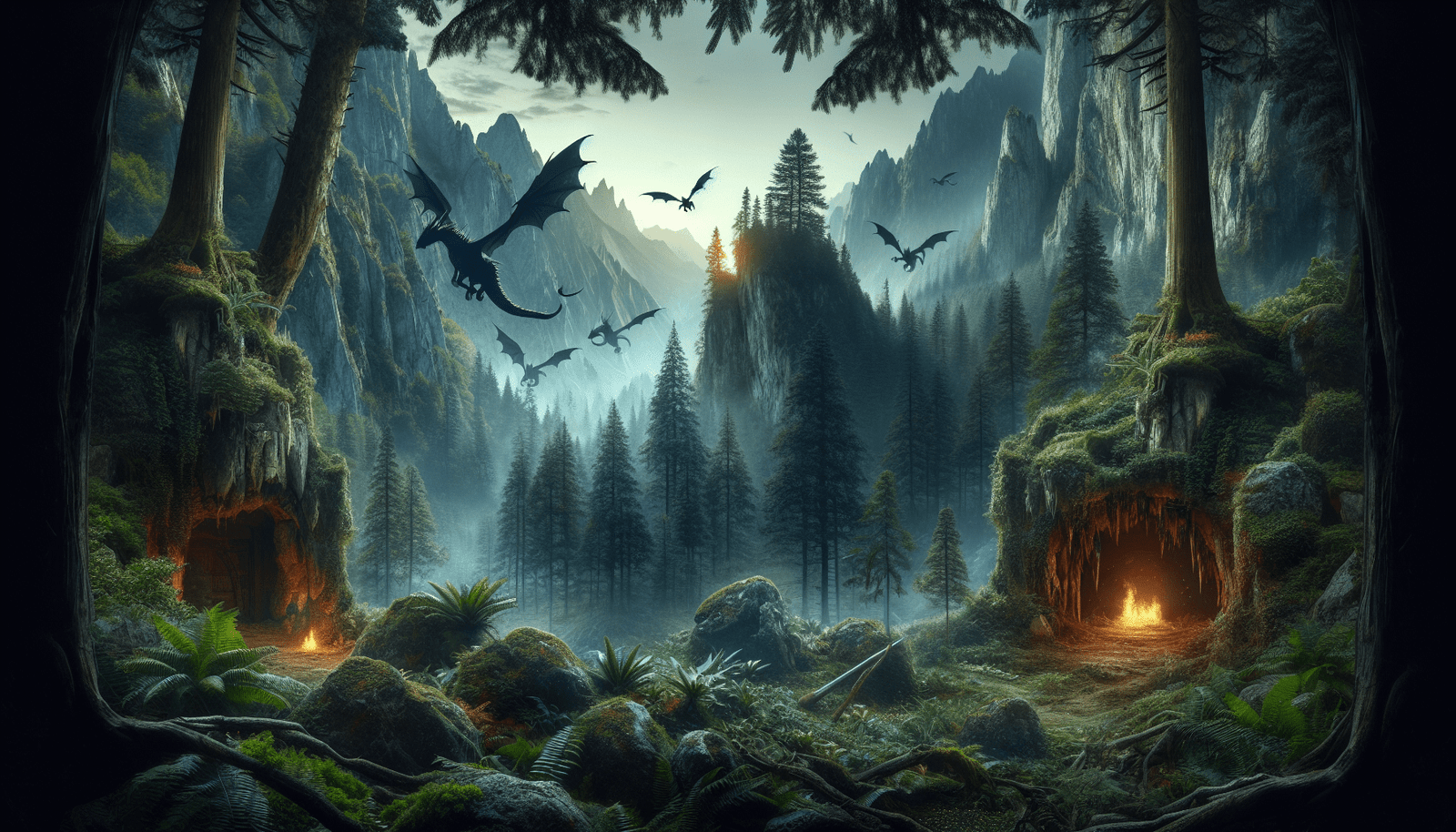Dragons, the mythical creatures that have captivated imaginations for centuries, have long been shrouded in mystery. In this article, we will explore the hidden habitats of dragons, unveiling the locations where these majestic beings are said to dwell. From the towering peaks of ancient mountains to the depths of enchanted forests, the hidden habitats of dragons hold secrets waiting to be discovered. Get ready to embark on a journey into the realms where legend and reality collide.
The Hidden Habitats of Dragons
Dragons, mystical creatures of legend and lore, are known for their ability to inhabit a wide range of environments. While many may envision dragons dwelling solely in caves or atop towering mountains, the truth is that these magnificent beings have adapted to various habitats across the world. From mountain peaks to underwater caverns, volcanic regions to enchanted forests, dragons have carved out their own hidden havens where they can thrive and flourish.
Mountain Peaks
One of the most iconic habitats for dragons is the lofty mountain peaks. With their immense size and strength, dragons are well-suited to withstand the harsh conditions found at high altitudes. These majestic beings have developed unique adaptations to survive in such challenging environments.
High-altitude Adaptations
Dragons dwelling in mountain peaks have developed physical features that enable them to withstand the thin air and freezing temperatures. Their lung capacity is larger than that of most creatures, allowing them to extract oxygen efficiently from the rarefied atmosphere. Additionally, dragons possess thick scales, providing insulation against the biting cold.
Nesting Habits
Mountain peaks offer dragons a vantage point from which they can survey their surroundings and protect their young. Dragons create elaborate nests, often constructed from rocks and lined with soft materials such as moss or feathers. These nests are strategically placed in crevices or sheltered areas, providing protection from the elements and potential predators.
Food Sources
In their mountain habitats, dragons have adapted their diet to include a wide variety of prey. They are skilled hunters, capable of swooping down from great heights to catch their unsuspecting victims. Mountain goats, deer, and even smaller dragons become part of their menu, ensuring that these creatures maintain their formidable strength and energy.
Perils and Predators
Despite their dominance in the sky, dragons in mountain peaks face their fair share of challenges. Harsh weather conditions, such as blizzards and avalanches, pose a threat to their survival. Additionally, other apex predators, such as eagles or rival dragons, may vie for territory, leading to intense territorial disputes. Yet, with their formidable size and strength, dragons have managed to establish themselves as the supreme rulers of the mountains.
Underwater Caverns
While dragons are often associated with the skies, their adaptability extends to the depths of the oceans as well. Underwater caverns offer these creatures a mysterious and hidden sanctuary where they can explore the hidden wonders of aquatic realms.
Aquatic Adaptations
To thrive in the deep sea, dragons have developed specialized adaptations. Their sleek, streamlined bodies enable them to move swiftly through the water, while their scales provide protection against the pressure of the depths. Additionally, many dragons possess gills located on their necks, allowing them to extract oxygen from the water and breathe comfortably beneath the waves.
Breathing Mechanisms
While some dragons rely solely on their gills for respiration, others have evolved the ability to breathe both underwater and in the air. These dragons possess a dual respiratory system, with lungs for breathing in the air while their gills facilitate respiration underwater. This unique adaptation enables them to explore both realms and adapt to changing environments.
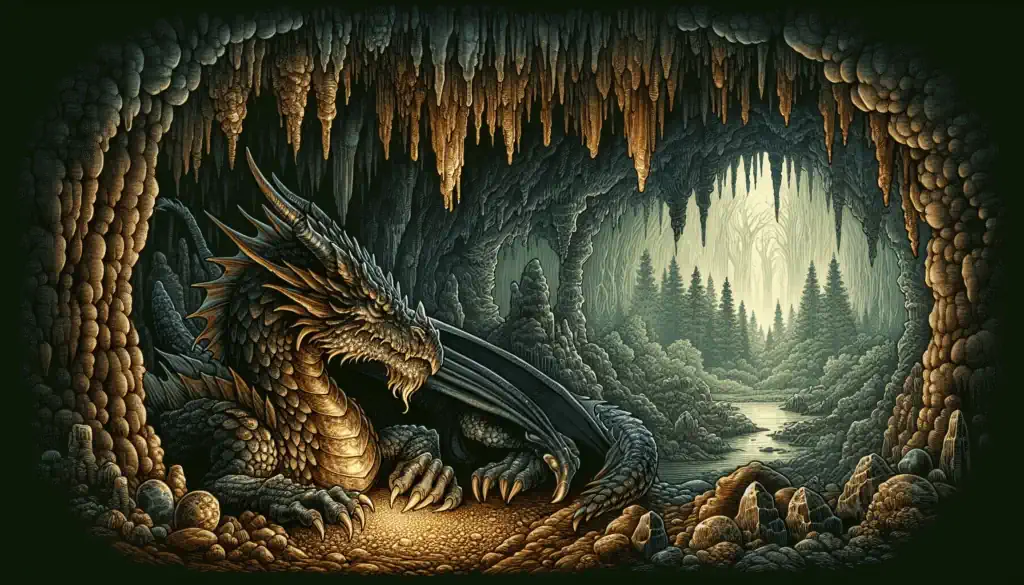
Bioluminescent Capabilities
In the depths of underwater caverns, where sunlight fails to penetrate, bioluminescence becomes crucial for survival. Many dragons have developed bioluminescent features, emitting soft glows to navigate the dark abyss and communicate with others of their kind. These mesmerizing displays create an ethereal ambiance in the depths where dragons dwell.
Survival Tactics
Underwater caverns can be treacherous environments, and dragons have honed their survival skills to thrive in such conditions. They possess acute senses, allowing them to detect the slightest movements or changes in their surroundings. Dragons often camouflage themselves among the vibrant coral reefs or blend seamlessly into the rocky seabed, remaining unseen and undisturbed by potential threats.
Volcanic Regions
Perhaps one of the most inhospitable habitats, volcanic regions provide an unlikely sanctuary for dragons. These fiery landscapes, with their erupting volcanoes and unforgiving terrain, showcase the resilience and adaptability of these mythical creatures.
Heat Tolerance
Dragons residing in volcanic regions possess an extraordinary heat tolerance. Their scales are not only a form of protection but also act as a shield against the scorching temperatures. Dragons’ internal physiology is uniquely adapted to withstand the extreme heat, allowing them to navigate the searing landscapes with ease.
Feeding on Geothermal Energy
Volcanic regions offer an abundant source of energy, in the form of geothermal activity, that dragons have learned to harness for their sustenance. They can absorb the intense heat emanating from the Earth’s core, converting it into a source of nourishment. This geothermal energy fuels the dragons’ formidable powers and sustains them in the harshest environments.
Magma Manipulation
Dragons dwelling amidst volcanic regions have developed an extraordinary affinity for manipulating magma. With a mere thought, they can control the flow of molten rock, using it both defensively and offensively. This unique ability allows them to reshape the landscape around them and defend their territories from potential threats.
Thermal Regulation
While the temperatures in volcanic regions can be extreme, dragons have evolved efficient mechanisms for thermal regulation. They possess specialized sweat glands that secrete a heat-resistant oil, which coats their scales and shields them from the intense heat. Dragons can also control their body temperature by absorbing or releasing heat to maintain equilibrium, even in the most extreme volcanic environments.
Enchanted Forests
Among the green depths of enchanted forests, dragons find solace and enchantment. These magical habitats are teeming with wonders, fairy creatures, and ancient trees, offering dragons a realm of unparalleled beauty and mystique.
Camouflaging Abilities
Dragons dwelling in enchanted forests have developed the ability to blend seamlessly into their surroundings. Their scales adopt the vibrant hues of the flora and fauna around them, rendering them nearly invisible to the naked eye. This chameleon-like adaptation allows dragons to move stealthily through the forest, their presence unknown to all but the most perceptive observers.
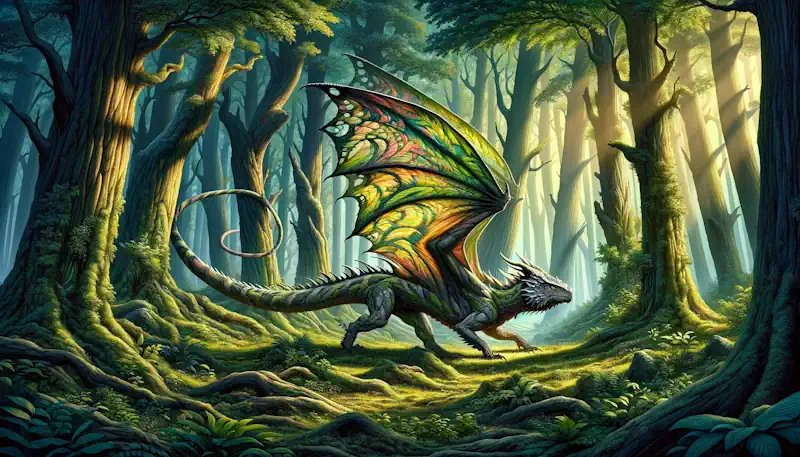
Interaction with Magical Creatures
Enchanted forests are not only home to dragons but also serve as meeting grounds for a myriad of magical creatures. Dragons have established complex relationships with these creatures, forming alliances or engaging in elaborate rituals with the forest’s inhabitants. Fairies, unicorns, and other mystical beings view dragons as guardians and allies, working together to protect the enchanted wonders of the forest.
Forest Guardian Status
Dragons play a vital role in the balance and protection of enchanted forests. They assume the position of forest guardians, ensuring harmony between the magical creatures and the delicate ecosystem. Their immense size and power become a deterrent to those who would seek to harm the forest or disrupt its enchantment.
Feeding on Mystical Plants
Enchanted forests harbor a plethora of mystical plants known for their unique properties. Dragons have adapted their diet to include these plants, which provide not only sustenance but also enhanced magical abilities. By consuming these rare flora, dragons absorb and channel their inherent enchantments, imbuing themselves with the forest’s magic.
Desolate Wastelands
While dragons are often associated with beauty and grandeur, they are equally at home in the desolate wastelands. Barren landscapes devoid of life do little to deter these creatures, as they have adapted to utilize every resource available and thrive in the harshest conditions.
Surviving Extreme Conditions
Desolate wastelands present dragons with harsh environments characterized by scorching heat, biting cold, or arid deserts. Their thick scales, designed to withstand the most extreme environments, protect them from the harsh elements. Dragons have also developed the ability to go for extended periods without food or water, allowing them to survive in an environment that offers little sustenance.
Feeding on Scavenged Remains
With limited food sources available in desolate wastelands, dragons have become experts at scavenging. They make use of every opportunity to feed on the remains of deceased creatures, whether it be carrion or the carcasses of unfortunate prey. In these barren landscapes, waste becomes a source of sustenance for dragons, ensuring their survival in inhospitable regions.
Symbiotic Relationships
Desolate wastelands may seem devoid of life, but dragons have managed to establish symbiotic relationships with certain species that can thrive under such conditions. Some dragons form mutually beneficial alliances with scavengers or desert-dwelling creatures, sharing food sources or offering protection in exchange for companionship. These relationships provide companionship and increased chances of survival for both parties involved.
Lair Construction
Dragons in desolate wastelands construct elaborate lairs, hidden deep within the harsh terrain. These lairs provide shelter from extreme weather conditions and potential predators. Dragons possess an innate ability to transform the desolate landscape into a maze of tunnels and chambers that serve as both a sanctuary and a home.
Dark Abysses
In the dark depths of the ocean, where light rarely penetrates, dragons have found their mysterious refuge. Dark abysses provide these creatures with an environment that few others can navigate, allowing them to dwell in secrecy and retain a sense of mystique.
Eyes Adapted to Darkness
Navigating the dark abysses requires dragons to possess special adaptations. Their eyes have evolved to perceive even the faintest traces of light, allowing them to navigate and hunt in the depths where darkness reigns. Their pupils dilate to an extraordinary extent, enabling them to capture whatever scarce light filters down from the surface.
Bioluminescent Features
One of the most striking adaptations of dragons in dark abysses is their bioluminescence. These creatures possess an array of photophores across their bodies, emitting a soft, ethereal glow that pierces the darkness. The bioluminescent displays serve multiple purposes, aiding in communication, attracting prey, and even mesmerizing potential threats.
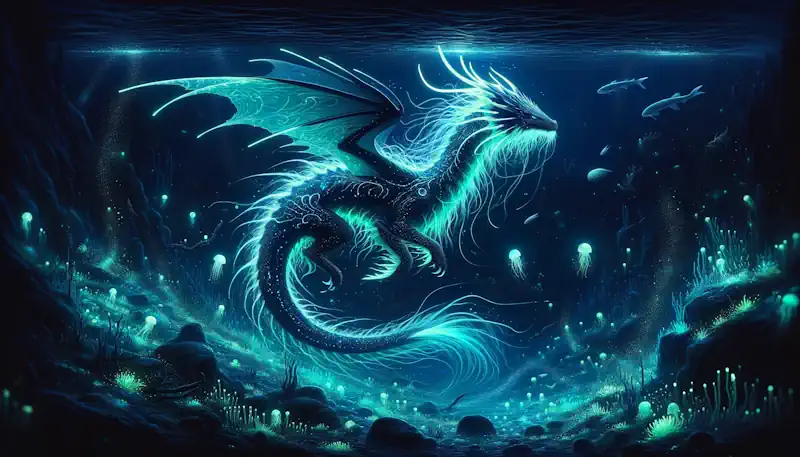
Hunting Techniques
In the pitch-black realm of the dark abysses, hunting becomes a delicate balance of stealth and precision. Dragons have developed various techniques to overcome the challenges posed by their lightless environment. Some rely on their acute senses, detecting the faintest vibrations or movements created by their prey. Others employ their bioluminescent displays to lure unsuspecting creatures before striking with lightning speed.
Navigating in the Depths
Navigating the sprawling expanse of the dark abysses would be a daunting task for most creatures, but not for dragons. These beings possess an exceptional sense of direction, using a combination of magnetic sensitivity and echolocation to chart their course through the depths. Their ability to navigate complex undersea landscapes allows them to explore hidden crevices and locate prey or potential mates.
Mystical Islands
Nestled amidst the azure waters, mystical islands form captivating habitats for dragons. These islands, shrouded in enchantment and tinged with a touch of magic, offer dragons seclusion, bountiful resources, and a connection to the ethereal realms.
Island Formation and Isolation
Mystical islands often emerge from the convergence of magical forces, their creation veiled in the mysteries of the world. These islands are isolated from the mainland, hidden by mystical energies that limit access to only the chosen few. It is on these islands that dragons find refuge and carve out their own domains.
Interaction with Local Fauna
Mystical islands house rich and diverse ecosystems, populated by fantastical creatures found nowhere else in the world. Dragons have established intricate relationships with the local fauna, playing roles ranging from protectors to ambassadors. They share their wisdom and magical abilities with these creatures, fostering a harmonious coexistence on the islands.
Guarding Precious Treasures
Mystical islands often harbor invaluable treasures, both material and ephemeral. Dragons are entrusted with the guardianship of these treasures, watching over them with unwavering dedication. These treasures might include ancient relics of power, magical artifacts, or even the collective knowledge of generations past. The dragons’ presence ensures that these treasures remain safe and secure.

Cultural Significance
Mystical islands encompass not only natural wonders but also cultural significance. They serve as sacred grounds and pilgrimage sites for those who seek spiritual enlightenment or magical knowledge. Dragons play an essential role in the cultures of these islands, embodying wisdom, power, and the ethereal connections of the mystical realms.
Ancient Ruins
In the remnants of once-great civilizations, dragons have established their homes. Ancient ruins, with their echoes of bygone eras and the secrets they guard, offer these creatures a sanctuary where history and mysticism intertwine.
Role in Mythology
Dragons have long been woven into the tapestry of human mythology, and ancient ruins bear witness to their presence throughout history. The stories and legends surrounding dragons serve as a reminder of their power, wisdom, and mystical connection to the world. In many cultures, dragons are revered as divine beings or feared as formidable adversaries.
Coexistence with Civilization
Ancient ruins present a unique juxtaposition of the old and the new. While humans might no longer dwell in these once-great cities, dragons have stepped in to claim these forgotten domains. In some cases, humans and dragons coexist on the fringes of these ruins, forging delicate alliances or maintaining an understanding of mutual respect.
Buried Treasures
Ancient ruins are treasure troves, both for dragons and those who seek to uncover the secrets of the past. For dragons, these ruins offer an opportunity to discover and safeguard ancient artifacts imbued with magical energies. These invaluable treasures connect dragons to the history of civilizations long gone, offering insights into the world’s forgotten mysteries.
History of Dragon-Human Interactions
Ancient ruins often reveal the intricate web of interactions between dragons and humans throughout history. Hieroglyphs, murals, and surviving texts depict dragon-human interactions, shedding light on ancient customs, rituals, and beliefs. These glimpses into the past deepen our understanding of the profound and enduring connections between humans and dragons.
Subterranean Labyrinths
Beneath the surface of the earth, in the winding tunnels of subterranean labyrinths, dragons find their abodes. These sprawling networks of caves and tunnels conceal hidden worlds where dragons can thrive away from prying eyes.
Cave Adaptations
Dragons dwelling in subterranean labyrinths have adapted their physical attributes to navigate the dark, cramped spaces. They possess slender, flexible bodies and elongated tail structures that enable them to maneuver through narrow passages with ease. Their sharp claws and reinforced wings allow them to cling to cave walls and ceilings, providing them with an advantage in the intricate maze of tunnels.
Interaction with Underground Creatures
Subterranean labyrinths are teeming with a plethora of creatures that have adapted to life in the darkness. Dragons have formed unique relationships with these subterranean dwellers, often aiding each other in the pursuit of survival. Some dragons establish symbiotic alliances with blind creatures, using their acute senses to guide the way, while others develop predator-prey relationships with burrowing creatures.
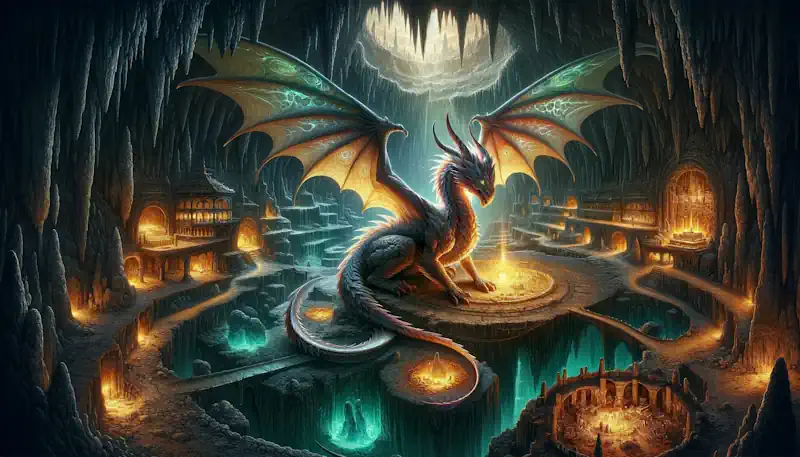
Hoard Protection and Nesting Habits
Dragons dwelling in subterranean labyrinths have a distinct advantage when it comes to protecting their hoards and nesting sites. These hidden domains provide natural fortifications against potential thieves or invaders. Dragons meticulously craft nest chambers deep within the labyrinth’s heart, hidden away from view and offering a safe haven for their precious eggs or hatchlings.
Living in Endless Darkness
The darkness of the subterranean labyrinth becomes a realm of comfort and familiarity to dragons. Their eyes have adapted to the absence of light, allowing them to perceive even the faintest glimmers in the perpetual darkness. Dragons possess an unparalleled connection to the realm of the subterranean, finding solace and purpose as they explore and guard their intricate underground domains.
Final Thoughts
The hidden habitats of dragons encompass a wide range of environments, each uniquely suited to the needs and abilities of these magnificent creatures. From mountain peaks and underwater caverns to volcanic regions and enchanted forests, dragons have found havens where they can thrive and connect with their mystical nature. These hidden habitats invite us to delve into the mysteries of the world, reminding us of the enchantment and awe that dragons bring to our imaginations.

